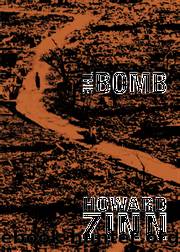The Bomb by Zinn Howard

Author:Zinn, Howard
Language: eng
Format: epub
Tags: Howard Zinn, WWII, atomic bombings of Japan, abolition of all nuclear weapons
Publisher: City Lights Publishers
The Bombing of Royan
In mid-April of 1945, a combined air-ground attack completed the destruction of the French seaside resort of Royan, a town of ancient châteaux and lovely beaches (a favorite spot of Picasso) on the Atlantic coast near Bordeaux. It was ten months after D-day, the invasion of Western Europe by Allied Forcesâand three weeks before the final surrender of Germany. The official history of the U.S. Army Air Forces in World War II refers briefly to the attack on Royan:
On the 14 through 16 April more than 1,200 American heavies went out each day to drop incendiaries, napalm bombs, and 2,000-pound demolition bombs on stubborn German garrisons still holding out around Bordeaux. The bombing was effective, and French forces soon occupied the region.
According to the official history those bombs were dropped âon stubborn German garrisons.â This is misleading. The bombs were dropped in the general vicinity of Royan, where there were German garrisons (mostly outside the town) and where there were also civilian occupants of the town. It was my participation in this mission, as a bombardier with the 490th Bomb Group, that prompted me, after the war, to inquire into the bombing of Royan. At the time, it seemed just another bombing mission, with a slightly different target, and a slightly different cargo of bombs. We were awakened in the early hours of morning, went to the briefing where we were told our job was to bomb pockets of German troops remaining in and around Royan, and that in our bomb bays were thirty 100-pound bombs containing âjellied gasoline,â a new substance (now known as napalm). Our bombs were not precisely direct-ed at German installations but were dropped by toggle switch over the Royan area, on seeing the bombs of the lead ship leave the bomb bayâa device good for saturation bombing, not pinpoint bombing (aside from the fact that the Norden bombsight, which we were trained to use, could not be counted on to hit enemy installations and miss nearby civilians from a height of 25,000 feet). The toggle switch was connected to an intervalometer which automatically dropped the bombs, after the first fell, in a timed sequence. From our great height, I remember distinctly seeing the bombs explode in the town, flaring like matches struck in fog. I was completely unaware of the human chaos below.
⢠⢠â¢
A letter from Colonel H. A. Schmidt, of the Office of the Chief of Military History, Department of the Army, responding to my request for information on the bombing of Royan, stated:
The liberation of the port of Bordeaux required the reduction of the bridgeheads of Royan, la Pointe de Grave and Oléron. The Royan sector was the principal German garrison holding out in the Bordeaux area, and first priority in the operations. The Eighth U.S. Air Force paved the way of the Allied ground forces by massive bombing.
The quick, casual description of potentially embarrassing episodes is common in histories written by men in government. Winston Churchill, who was
Download
This site does not store any files on its server. We only index and link to content provided by other sites. Please contact the content providers to delete copyright contents if any and email us, we'll remove relevant links or contents immediately.
| Africa | Americas |
| Arctic & Antarctica | Asia |
| Australia & Oceania | Europe |
| Middle East | Russia |
| United States | World |
| Ancient Civilizations | Military |
| Historical Study & Educational Resources |
The Dawn of Everything by David Graeber & David Wengrow(1652)
The Bomber Mafia by Malcolm Gladwell(1583)
Facing the Mountain by Daniel James Brown(1504)
Submerged Prehistory by Benjamin Jonathan; & Clive Bonsall & Catriona Pickard & Anders Fischer(1420)
Wandering in Strange Lands by Morgan Jerkins(1372)
Tip Top by Bill James(1350)
Driving While Brown: Sheriff Joe Arpaio Versus the Latino Resistance by Terry Greene Sterling & Jude Joffe-Block(1339)
Evil Geniuses: The Unmaking of America: A Recent History by Kurt Andersen(1318)
Red Roulette : An Insider's Story of Wealth, Power, Corruption, and Vengeance in Today's China (9781982156176) by Shum Desmond(1315)
The Way of Fire and Ice: The Living Tradition of Norse Paganism by Ryan Smith(1305)
American Kompromat by Craig Unger(1270)
It Was All a Lie by Stuart Stevens;(1265)
F*cking History by The Captain(1254)
American Dreams by Unknown(1235)
Evil Geniuses by Kurt Andersen(1224)
Treasure Islands: Tax Havens and the Men who Stole the World by Nicholas Shaxson(1222)
White House Inc. by Dan Alexander(1179)
The First Conspiracy by Brad Meltzer & Josh Mensch(1140)
The Fifteen Biggest Lies about the Economy: And Everything Else the Right Doesn't Want You to Know about Taxes, Jobs, and Corporate America by Joshua Holland(1090)
